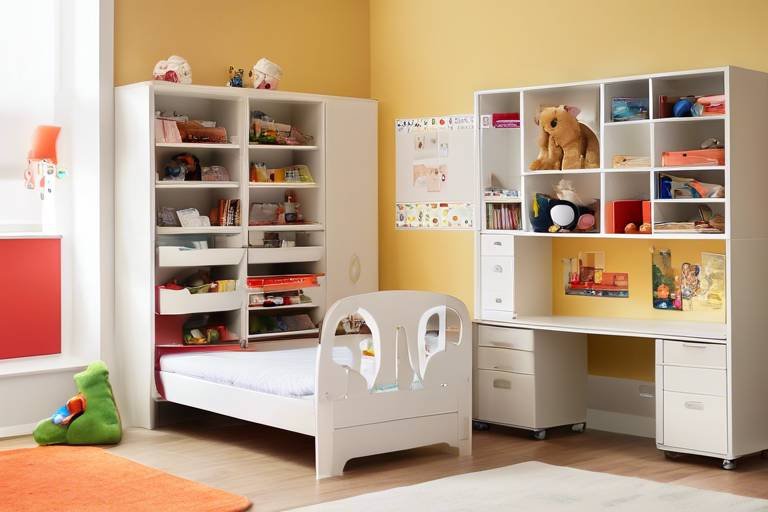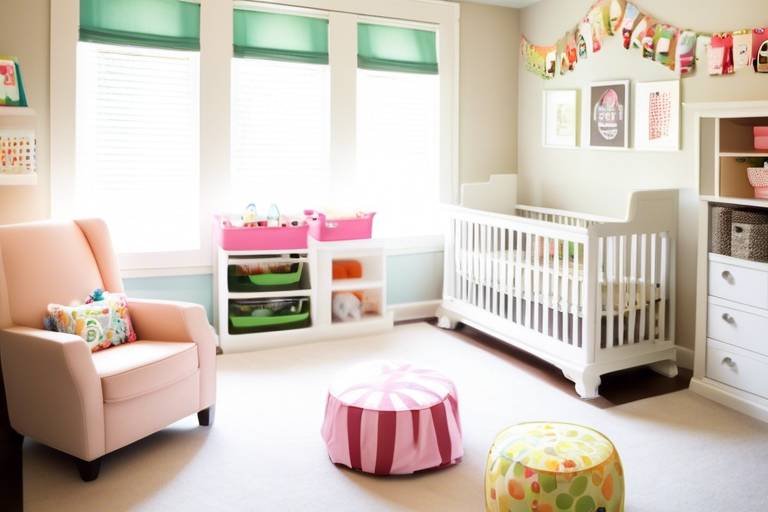Organizing and Displaying Your Family Photos
In today's fast-paced world, family photos are more than just images; they are windows into our past, capturing moments that tell the stories of our lives. Organizing and displaying these precious memories can feel overwhelming, but it doesn't have to be! With the right approach, you can transform a chaotic collection of photos into a beautifully curated gallery that not only showcases your family's history but also adds warmth and character to your home.
Imagine walking into your living room and being greeted by a stunning gallery wall filled with vibrant snapshots of family vacations, birthday celebrations, and candid moments. Each photo not only sparks joy but also serves as a conversation starter, allowing you to reminisce about the good times with friends and family. In this article, we’ll explore effective methods for organizing and displaying your family photos, providing insights into digital solutions, creative displays, and tips for preserving memories for future generations.
Whether you’re a digital native or someone who cherishes physical prints, the journey of organizing your family photos begins with understanding the importance of proper storage solutions. After all, what good are your memories if they’re hidden away in a dusty box or lost in the depths of your smartphone? From traditional photo albums to modern digital formats, we’ll delve into various storage options that keep your memories safe and accessible.
But we won't stop there! We'll also discuss the significance of digitizing your photo collection in this digital age. Think about it: having your cherished memories at your fingertips, ready to be shared with loved ones at a moment's notice. The benefits of digitization are numerous, including ease of access, sharing capabilities, and protection against physical deterioration. So, let’s get started on transforming your family photos into a well-organized treasure trove of memories that can be enjoyed for years to come!

Choosing the Right Storage Solutions
When it comes to preserving your family photos, selecting the right storage solutions is not just a matter of convenience; it's essential for ensuring that your cherished memories stand the test of time. Think of your photos as precious gems; without a proper setting, they can lose their luster and value. So, where do you start? The first step is to consider the various options available, each with its unique advantages and potential drawbacks.
Traditional photo albums and boxes have been the go-to storage solutions for decades. They offer a tangible way to flip through memories, allowing you to hold the past in your hands. However, they can take up a lot of physical space, and over time, the materials used in some albums can deteriorate, potentially harming the photos they contain. To mitigate this, consider using acid-free materials that won’t damage your photos over time. Investing in high-quality albums can make a significant difference in the longevity of your collection.
On the other hand, digital storage solutions are becoming increasingly popular. With the advent of technology, you can now store thousands of photos on a single device. This not only saves space but also provides easy access and sharing options. Imagine being able to show your family vacation photos to relatives across the globe with just a few clicks! However, relying solely on digital formats comes with its own set of challenges, such as the risk of data loss due to hardware failure or accidental deletion.
To strike a balance between physical and digital storage, many people are adopting a hybrid approach. This method combines the tactile pleasure of physical albums with the convenience of digital backups. You might choose to keep your most treasured photos in a beautifully arranged album while digitizing the rest for easy access. This way, you can enjoy the best of both worlds!
Here’s a quick comparison of different storage solutions:
| Storage Type | Advantages | Disadvantages |
|---|---|---|
| Physical Albums | Tangible, nostalgic, easy to share with guests | Space-consuming, potential for deterioration |
| Photo Boxes | Easy organization, can hold various sizes | Can be bulky, less visual impact |
| Digital Storage | Space-efficient, easy to access and share | Risk of data loss, requires tech-savvy |
| Cloud Storage | Accessible from anywhere, automatic backups | Requires internet access, potential privacy concerns |
Ultimately, the choice of storage solutions will depend on your personal preferences and lifestyle. Are you the type who loves to flip through physical albums, or do you prefer the convenience of digital access? Whichever route you choose, the most important thing is to ensure that your family photos are stored in a way that keeps them safe and accessible for future generations to enjoy.
- What is the best way to store physical photos? Use acid-free albums and boxes to prevent deterioration.
- How can I safely digitize my photos? Use a high-quality scanner and consider professional services if you have a large collection.
- Is cloud storage safe for my family photos? Yes, but ensure you choose a reputable provider and regularly back up your data.
- How often should I back up my digital photos? Regularly, ideally every few months or after significant events.

Digitizing Your Photo Collection
In today's fast-paced digital world, is not just a trend; it’s a necessity. Imagine having your cherished memories at your fingertips, accessible anytime and anywhere. Whether it's a family reunion, a memorable vacation, or those spontaneous moments that make life beautiful, digitizing allows you to preserve these memories in a way that physical photos simply cannot. Not only does it make sharing with family and friends a breeze, but it also protects your photos from the ravages of time, such as fading, tearing, or accidental spills.
One of the greatest advantages of digitization is the ease of access it provides. Instead of rifling through dusty boxes or cumbersome albums, you can simply pull out your smartphone or computer and relive those precious moments instantly. Plus, digital photos can be easily organized into folders or albums, making it simpler to find specific memories when you want to reminisce.
But how do you go about digitizing your collection? It all starts with the right tools and techniques. Scanning your photos is the most common method, but it’s not just about hitting a button and hoping for the best. The quality of your scans can make a huge difference in how your memories are preserved. High-resolution scans capture the fine details of your images, ensuring that every smile and every sunset is represented in stunning clarity.
When it comes to scanning, there are a few techniques and tools that can help you achieve the best results. Here are some key points to consider:
- Flatbed Scanners: These are the most common types of scanners and are excellent for scanning photos. They provide high resolution and are gentle on your pictures.
- Photo Scanners: Designed specifically for photos, these scanners can quickly digitize multiple images at once, saving you time.
- Smartphone Apps: If you don’t have a scanner, there are several apps available that can turn your smartphone into a scanner. While they may not match the quality of dedicated scanners, they are a convenient option.
Once you’ve scanned your photos, you might find that they need some editing. This is where software options come into play. Programs like Adobe Photoshop or Lightroom can help you enhance your images, correct colors, and even restore faded photos. Imagine breathing new life into a photo that has been tucked away for years!
After digitizing your photos, the next critical step is to ensure they are backed up securely. Think of digital backups as your safety net. You wouldn’t want to lose years of memories due to a hard drive failure or accidental deletion. Consider the following backup strategies:
- Cloud Storage: Services like Google Drive, Dropbox, or iCloud allow you to store your photos online, making them accessible from any device with an internet connection.
- External Hard Drives: These provide a physical backup option. Simply transfer your digitized photos to an external drive and store it in a safe place.
In conclusion, digitizing your photo collection is a rewarding process that not only preserves your memories but also enhances your ability to share and enjoy them. With the right tools and techniques, you can ensure that your family's legacy is protected for generations to come.
Q: How do I choose the best scanner for my photos?
A: Look for a scanner that offers high resolution (at least 300 dpi) and is designed for photos. Flatbed scanners are usually a great choice for their versatility.
Q: Can I use my smartphone to digitize photos?
A: Yes! There are many apps available that allow you to scan photos using your smartphone. While they may not match the quality of a dedicated scanner, they are convenient and can produce acceptable results.
Q: How often should I back up my digital photos?
A: It's a good practice to back up your photos regularly, ideally after any significant addition to your collection. Monthly backups can help ensure you don't lose any new memories.

Scanning Techniques and Tools
When it comes to preserving your family photos, scanning is a game-changer. It’s like giving your cherished memories a new lease on life, allowing you to keep them safe and sound in a digital format. But how do you ensure that the quality of your scans does justice to the original images? Well, let’s explore some effective scanning techniques and tools that can help you achieve stunning results.
First off, the type of scanner you choose can make a significant difference in the quality of your digitized photos. There are several options available, ranging from flatbed scanners to handheld models. Flatbed scanners are generally recommended for photographs because they allow for a more controlled scanning environment and can handle various photo sizes. On the other hand, handheld scanners offer portability and ease of use, but they may not provide the same level of detail.
Here’s a quick breakdown of the most common types of scanners:
| Type of Scanner | Pros | Cons |
|---|---|---|
| Flatbed Scanner | High quality, versatile, handles various sizes | Bulky, less portable |
| Handheld Scanner | Portable, easy to use | May lack detail, requires steady hand |
| Photo Scanner | Designed specifically for photos, high resolution | Can be expensive |
Once you’ve selected your scanner, it’s essential to consider the scanning resolution. A higher resolution means more detail, which is crucial for preserving the quality of your photos. Aim for at least 300 DPI (dots per inch) for standard prints, but if you plan to enlarge any images, consider scanning at 600 DPI or higher. This way, you ensure that every little detail shines through, making your digital copies as vibrant as the originals.
Another important aspect of scanning is the color settings. Make sure to set your scanner to the appropriate color mode. For color photos, use the RGB mode, while black and white photos should be scanned in grayscale. This simple adjustment can drastically affect how your photos appear once digitized.
After scanning, you might find that your images need a little touch-up to look their best. This is where photo editing software comes into play. Programs like Adobe Photoshop, GIMP, or even user-friendly options like Canva can help you enhance your scanned images. You can adjust brightness, contrast, and colors, or even remove any blemishes or dust that may have appeared during the scanning process.
In summary, the right tools and techniques can elevate your photo scanning experience. By choosing the appropriate scanner, adjusting your settings, and utilizing editing software, you can create beautiful digital versions of your family memories that will last for generations. So, grab your scanner and start preserving those precious moments today!

Choosing a Scanner
When it comes to digitizing your cherished family photos, the scanner you choose plays a pivotal role in ensuring that your memories are preserved with the utmost clarity and detail. With so many options available on the market, it can feel overwhelming to decide which scanner will best suit your needs. First and foremost, consider the type of photos you will be scanning. Are they small snapshots, large prints, or perhaps even negatives? This will help narrow down your choices significantly.
There are primarily three types of scanners you might consider:
- Flatbed Scanners: These are versatile and can handle a variety of photo sizes and types. They are ideal for scanning both prints and documents, making them a popular choice for families looking to digitize a mixed collection.
- Sheet-fed Scanners: If you have a large number of photos to scan, a sheet-fed scanner can save you time. They allow you to load multiple pages at once, but keep in mind that they may not be as gentle with delicate photographs.
- Film Scanners: For those with a collection of negatives or slides, investing in a dedicated film scanner is essential. These scanners are designed specifically for film and can produce high-quality images that capture the nuances of your original prints.
Another factor to consider is the resolution of the scanner. The higher the resolution, the better the quality of the scanned image. Look for a scanner that offers at least 300 DPI (dots per inch) for standard photo sizes, but if you want to preserve larger prints or fine details, aim for a scanner that provides 600 DPI or higher.
Don’t forget about the software that comes with the scanner. Some scanners include advanced editing software that can help you enhance your images post-scan. Features like color correction, dust removal, and cropping can make a significant difference in the final product. Additionally, consider whether the scanner is compatible with your operating system and if the setup process is user-friendly.
Finally, it’s wise to read reviews and perhaps even test a few models if possible. Look for scanners that have a reputation for reliability and quality. After all, you want your family memories to be preserved in the best way possible, so investing in a quality scanner is a decision you won’t regret.
Q1: What is the best scanner for photos?
A1: The best scanner for photos depends on your specific needs. Flatbed scanners are versatile, while film scanners are ideal for negatives. Consider resolution and included software as well.
Q2: How do I know what resolution to scan my photos at?
A2: For standard prints, 300 DPI is sufficient, but for larger prints or detailed images, opt for 600 DPI or higher to capture all the nuances.
Q3: Can I use my smartphone to scan photos?
A3: Yes, there are several apps available that allow you to scan photos using your smartphone. However, the quality may not match that of a dedicated scanner.
Q4: What should I do with my scanned photos after digitizing?
A4: After digitizing, consider organizing them on your computer, creating backups on external drives or cloud storage, and perhaps even printing a few favorites to display at home.

Editing and Enhancing Scanned Photos
Once you've successfully scanned your cherished family photos, the next step is to enhance their appearance to ensure they look as vibrant and captivating as they did on the day they were taken. Just like a painter adds the final touches to a masterpiece, photo editing can transform your scanned images into stunning visuals that truly represent your memories. You might wonder, "What tools do I need to get started?" Well, fear not! There are a plethora of software options available that cater to different skill levels and needs.
For beginners, software like Adobe Photoshop Elements or Canva offers user-friendly interfaces and plenty of tutorials to guide you through basic editing tasks. These programs allow you to adjust brightness, contrast, and color saturation, ensuring that your photos pop with life. On the other hand, if you're a bit more tech-savvy, you might want to dive into Adobe Photoshop or Lightroom, which provide advanced features like layers, filters, and extensive retouching tools.
Here are some essential editing techniques to consider:
- Color Correction: Adjust the color balance to ensure your photos are true to life. This can involve correcting the white balance or enhancing specific colors.
- Sharpness and Clarity: Use sharpening tools to enhance the details in your photos. This is especially useful for older images that may have lost some clarity over time.
- Crop and Straighten: Sometimes, a simple crop can improve composition significantly. Don’t hesitate to straighten any tilted images to give them a polished look.
- Remove Blemishes: Utilize retouching tools to eliminate dust spots, scratches, or any unwanted elements that distract from the main subject of your photo.
After editing, it's crucial to save your images in high-quality formats. While JPEG is a commonly used format for sharing online, consider saving your edited photos as TIFF or PNG for archiving purposes, as these formats preserve more detail and quality. Remember, the goal is to maintain the essence of the original while enhancing its visual appeal.
Finally, don’t forget to create a backup of your edited photos! It’s a heart-wrenching experience to lose your hard work due to a technical glitch or hardware failure. By following these editing tips and utilizing the right tools, you can ensure that your scanned family photos not only look amazing but also stand the test of time.
Q: What is the best software for beginners to edit scanned photos?
A: For beginners, Adobe Photoshop Elements and Canva are excellent choices due to their user-friendly interfaces and helpful tutorials.
Q: How can I improve the quality of my scanned photos?
A: You can improve the quality by using editing techniques such as color correction, sharpening, cropping, and removing blemishes.
Q: What file format should I use for archiving my edited photos?
A: For archiving, it’s best to save your edited photos in TIFF or PNG formats, as they retain more detail compared to JPEG.
Q: Should I back up my edited photos, and how?
A: Yes, it’s crucial to back up your edited photos. You can use cloud storage services or external hard drives to ensure your memories are safe.

Creating Digital Backups
Backing up your digital photos is not just a precaution; it’s a necessity in today’s fast-paced, technology-driven world. Imagine losing years of precious family memories due to a hard drive crash or accidental deletion. It’s a nightmare that no one wants to face! Therefore, implementing a solid backup strategy is crucial to ensure that your cherished photos are safe and sound for generations to come.
When it comes to creating digital backups, there are several options available, each with its own set of benefits. You might find it helpful to think of your backups as a multi-layered safety net. This means using more than one method to store your photos. Here are some popular options:
- Cloud Storage: Services like Google Drive, Dropbox, and iCloud allow you to store your photos online, accessible from anywhere with an internet connection. This is a fantastic option for those who travel frequently or want to share their photos easily with family and friends.
- External Hard Drives: These are physical devices that you can connect to your computer. They offer a large amount of storage and are great for keeping a local copy of your photos. Just remember to store them in a safe place!
- USB Flash Drives: Compact and portable, USB drives are ideal for quick backups. However, they can easily be misplaced, so it’s wise to keep them in a designated spot.
To ensure your memories are well-preserved, consider the 3-2-1 backup rule: keep three copies of your data, on two different media types, with one copy stored off-site. This is an effective strategy that minimizes the risk of losing your precious photos. For instance, you could have your primary storage on your computer, a backup on an external hard drive, and a third copy in the cloud. This way, even if one method fails, you still have your memories safe and sound.
Another important aspect of creating digital backups is to regularly update them. It’s easy to forget about backups once they’re set up, but just like a garden, they need regular attention. Schedule monthly reminders to back up your new photos, ensuring that no memories are left unprotected. You can even automate this process with certain cloud services that offer automatic backups.
Finally, don’t forget to test your backups! It’s essential to periodically check if you can access your files and ensure that they are intact. Imagine the horror of needing a photo only to find that your backup is corrupted or inaccessible! Regular checks can save you from this potential disaster.
In conclusion, creating digital backups is a critical step in preserving your family photos. By utilizing a combination of cloud storage, external hard drives, and USB flash drives, along with following the 3-2-1 backup rule, you can rest easy knowing your memories are safe. So, what are you waiting for? Start backing up those precious moments today!
Q: How often should I back up my photos?
A: It’s recommended to back up your photos at least once a month, or more frequently if you take a lot of pictures.
Q: Can I use just one backup method?
A: While you can use just one method, it’s safer to use multiple methods (like the 3-2-1 rule) to ensure your photos are well-protected.
Q: What should I do if I accidentally delete a photo?
A: Check your recycle bin or trash folder first. If it’s not there, you may need to use recovery software or check your backups.

Creative Display Ideas
When it comes to showcasing your family photos, creativity knows no bounds! Imagine walking into your living room and being greeted by a stunning gallery wall filled with vibrant memories that tell your family's story. This artistic approach not only adds a personal touch to your home decor but also sparks conversations and evokes emotions every time you glance at it. To create a gallery wall, consider mixing various frame styles and sizes to add depth and interest. A combination of black and white photos with colorful ones can create a striking contrast that captivates the eye.
Another innovative way to display your family memories is through digital photo frames. These modern devices allow you to effortlessly showcase a rotating selection of your favorite images. With features like slideshow settings and remote control operation, digital frames provide a dynamic way to keep your cherished memories alive. Plus, updating the images is as easy as a few clicks, making it a convenient option for busy families. Imagine coming home to a different set of memories every week!
If you're looking for something more interactive, consider creating a photo book or a scrapbook. This hands-on approach not only allows you to curate your favorite photos but also lets you add personal touches like handwritten notes, stickers, and decorative elements. You can even involve your kids in the process, making it a fun family activity. This way, you not only display your memories but also create a cherished keepsake that can be passed down through generations.
For those who enjoy a more minimalist aesthetic, consider a floating shelf display. This involves installing shelves on your walls and arranging framed photos alongside decorative items like plants or books. The clean lines of a floating shelf can create an elegant and modern look while still allowing your family photos to shine. You can also change out the photos as seasons change, keeping your decor fresh and exciting.
Lastly, don't underestimate the power of a well-placed photo collage. This can be a large canvas print that combines multiple images into one cohesive piece, or a smaller arrangement of photos in a grid format. Collages can be a beautiful focal point in any room, capturing the essence of your family's journey in a single glance. Whether you opt for a professional service or create one yourself, a photo collage is sure to be a conversation starter.
In summary, displaying your family photos creatively not only enhances your home but also preserves those precious memories in a way that is both accessible and visually appealing. From gallery walls to digital frames, there are countless ways to bring your cherished moments to life. So, get creative and let your family's story shine!
1. How can I choose the best location for my photo displays?
Consider high-traffic areas like living rooms or hallways where family and guests can easily admire your photos. Natural light is also a great factor; however, be cautious of direct sunlight that may fade your images over time.
2. What are the best materials for framing my photos?
Wood and metal frames are popular choices as they provide durability and aesthetic appeal. Consider using acid-free mats to protect your photos from damage.
3. How often should I update my photo displays?
It’s a good idea to refresh your displays seasonally or whenever you have new photos that capture significant moments. This keeps your decor lively and reflects your family's current journey.

Gallery Wall Inspiration
Creating a gallery wall in your home is not just about hanging up photos; it’s about telling your family's story in a visually stunning way. Imagine walking into a room where your most cherished memories are displayed like pieces of art, each photo sparking joy and nostalgia. But how do you go about designing a gallery wall that not only looks great but also feels personal? Here are some creative tips to get you started!
First, consider the theme of your gallery wall. Do you want to showcase family vacations, milestones, or perhaps a mix of both? By selecting a theme, you can create a cohesive look that resonates with your family’s journey. For instance, if you choose a travel theme, you could include photos from different destinations, paired with souvenirs or maps as part of the display. This not only adds visual interest but also serves as a conversation starter for guests.
Next, think about the layout. A well-planned layout can transform a simple collection of photos into a stunning display. You can opt for a symmetrical arrangement for a more formal look or an asymmetrical style for a relaxed vibe. To visualize your design, lay the photos on the floor first, experimenting with different configurations. This way, you can see how the pieces interact with each other before committing to the wall.
Another essential element is the frames. Mixing and matching different frame styles can add depth and character to your gallery wall. Consider using a combination of materials—wood, metal, and even fabric—to create a dynamic look. You could also paint the frames in a consistent color to unify the display or go for a more eclectic feel by using a variety of colors and textures.
As you hang your photos, remember to pay attention to the spacing. A common mistake is to place photos too far apart or too close together. Aim for a spacing of about 2 to 4 inches between frames, depending on their size. This will ensure that each photo has its own space while still feeling like part of a cohesive collection. A good rule of thumb is to start at eye level; this will create a natural focal point in the room.
Lastly, don’t forget to incorporate non-photo elements into your gallery wall. Items like quotes, artwork, or even three-dimensional objects can add layers to your display. For example, you could include a small shelf to hold decorative items or a few plants to bring life to the arrangement. These elements will break up the visual monotony and make your gallery wall even more engaging.
In summary, creating a gallery wall is a fantastic way to celebrate your family's memories while enhancing your home decor. By choosing a theme, planning your layout, mixing frame styles, paying attention to spacing, and incorporating non-photo elements, you can craft a stunning visual narrative that reflects your family's unique story.
- How do I choose the right photos for my gallery wall? Select a mix of photos that represent different moments in your family's life. Consider including candid shots, formal portraits, and even artwork.
- What is the best way to arrange my gallery wall? Start by laying out the frames on the floor to experiment with different arrangements. Aim for a balance between symmetry and asymmetry based on your style preference.
- Can I use different frame styles? Absolutely! Mixing frame styles can add character to your gallery wall. Just be sure to maintain some consistency in color or material for cohesion.
- How high should I hang my photos? A good rule of thumb is to hang the center of your gallery at eye level, typically around 57 to 60 inches from the floor.

Utilizing Digital Frames
In today's fast-paced world, digital photo frames have emerged as a fantastic way to showcase your treasured family memories without the hassle of traditional frames. Imagine walking into your living room and being greeted by a rotating slideshow of your favorite moments—birthdays, holidays, and everyday joys—all displayed beautifully on a sleek device. Digital frames not only save space but also offer versatility that traditional frames simply can't match.
One of the standout features of digital frames is their ability to display a continuous stream of images. This means you can load hundreds of photos onto a single frame, allowing you to relive memories without the need to swap out pictures constantly. Most digital frames come with a slideshow feature, which lets you set the duration each photo is displayed, creating a dynamic visual experience. You can even customize transitions between images, adding a touch of flair to your display.
Another advantage is the ease of updating your displayed images. Many modern digital frames connect to Wi-Fi, enabling you to upload new photos directly from your smartphone or computer. This feature is especially beneficial for families who love to capture moments on the go. You can share recent vacations, family gatherings, or even spontaneous snapshots without needing to print or frame them physically. Just think of it as a digital scrapbook that’s always up-to-date!
When selecting a digital frame, consider the following factors to ensure you choose one that fits your needs:
- Screen Size: Larger screens provide a more impactful display, while smaller ones can fit into tighter spaces.
- Resolution: Higher resolution frames will display your photos with better clarity and detail.
- Storage Capacity: Ensure the frame has enough memory to hold your favorite images, or opt for one with expandable storage options.
- Connectivity Options: Look for frames that support Wi-Fi, Bluetooth, or USB connections for easy photo uploads.
Additionally, many digital frames come with remote controls, allowing you to change settings, switch photos, or adjust display settings from the comfort of your couch. Some advanced models even feature touch screens, making navigation a breeze. With the right digital frame, you can create a personalized gallery that reflects your family's unique story and style.
In conclusion, utilizing digital frames is a modern and engaging way to display your family photos. They not only enhance your home decor but also keep your cherished memories alive in a dynamic format. So, if you're looking to breathe new life into your photo displays, consider investing in a digital frame. It might just become the centerpiece of your living space, sparking joy and nostalgia every time you walk by!
Q1: How do I transfer photos to my digital frame?
A1: You can typically transfer photos via USB, SD card, or through Wi-Fi if your frame supports it. Many frames also have companion apps for easy uploading from your smartphone.
Q2: Can I display videos on a digital frame?
A2: Some digital frames support video playback, but this feature varies by model. Check the specifications before purchasing if this is important to you.
Q3: How do I maintain my digital frame?
A3: Maintenance is minimal! Just keep the screen clean and ensure the software is updated. Regularly refresh the photos to keep the display interesting.
Q4: Are digital frames energy-efficient?
A4: Yes, most digital frames are designed to be energy-efficient, especially models with automatic sleep functions that turn the display off when not in use.
Frequently Asked Questions
- What are the best ways to store family photos?
When it comes to storing family photos, you have several options. You can use traditional photo albums, archival boxes, or even digital formats. The key is to choose a method that keeps your memories safe and accessible. Albums are great for physical keepsakes, while digital storage allows for easy sharing and access.
- How do I digitize my photo collection?
Digitizing your photo collection is a fantastic way to preserve your memories. You can use a scanner to create high-resolution images of your prints. There are various scanning techniques available, and investing in a good quality scanner can make a huge difference in the final results. Once digitized, you can easily store, share, and back up your photos.
- What should I look for in a photo scanner?
Choosing the right photo scanner can be overwhelming with so many options available. Look for features like resolution, scanning speed, and the ability to handle different photo sizes. Flatbed scanners are usually best for photos, as they provide better quality than sheet-fed options. Don’t forget to check for software compatibility for editing!
- How can I enhance my scanned photos?
After scanning your photos, you might want to enhance them to improve their appearance. There are several software options available, like Adobe Photoshop or free alternatives like GIMP. You can adjust brightness, contrast, and colors, or even remove blemishes to make your cherished memories look their best.
- What are some effective backup strategies for my digital photos?
Backing up your digital photos is crucial to ensure they are safe from loss. You can use cloud storage services like Google Drive or Dropbox for easy access and sharing. Additionally, consider using external hard drives for offline backups. A good rule of thumb is to have at least two backup copies in different locations.
- What are some creative ways to display family photos at home?
Displaying family photos can add a personal touch to your home decor. Consider creating a gallery wall with a mix of framed photos and art pieces. Digital photo frames are another modern option, allowing you to showcase multiple images in a slideshow format. Get creative with your displays to reflect your family's personality!
- How can I create a gallery wall?
Creating a gallery wall is all about layout and design. Start by selecting a collection of your favorite photos and frames. Lay them out on the floor first to find a pleasing arrangement before hanging. Mix different frame styles and sizes for an eclectic look, or stick to a uniform style for a more cohesive feel.
- What are the benefits of using digital photo frames?
Digital photo frames are a fantastic way to display your family memories without taking up much space. They often come with features like slideshow capabilities, allowing you to enjoy a rotating display of your favorite images. Plus, they're easy to update, so you can keep your display fresh and current with new memories!



















